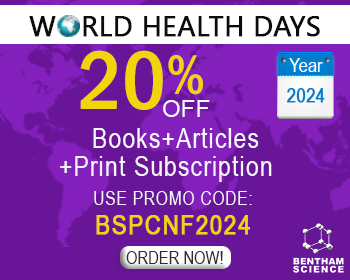Abstract
Sepsis is the main cause of death in critically ill patients with no effective treatment. Sepsis is lifethreatening organ dysfunction due to a dysregulated host response to infection. As a novel medical gas, molecular hydrogen (H2) has a therapeutic effect on many diseases, such as sepsis. H2 treatment exerts multiple biological effects, which can effectively improve multiple organ injuries caused by sepsis. However, the underlying molecular mechanisms of hydrogen involved in the treatment of sepsis remain elusive, which are likely related to anti-inflammation, anti-oxidation, anti-apoptosis, regulation of autophagy and multiple signaling pathways. This review can help better understand the progress of hydrogen in the treatment of sepsis, and provide a theoretical basis for the clinical application of hydrogen therapy in sepsis in the future.
Keywords: Sepsis, molecular hydrogen, organ injury, inflammation, oxidative stress, mechanisms.
[http://dx.doi.org/10.1001/jama.2016.0287] [PMID: 26903338]
[http://dx.doi.org/10.1016/S0140-6736(18)30696-2] [PMID: 29937192]
[http://dx.doi.org/10.1016/S0140-6736(19)32989-7] [PMID: 31954465]
[http://dx.doi.org/10.1164/rccm.201504-0781OC] [PMID: 26414292]
[http://dx.doi.org/10.1186/s13054-018-2186-7] [PMID: 30466493]
[http://dx.doi.org/10.1001/jama.2014.2637] [PMID: 24638143]
[http://dx.doi.org/10.1016/j.chest.2019.04.013] [PMID: 31047954]
[http://dx.doi.org/10.1038/nri.2017.36] [PMID: 28436424]
[http://dx.doi.org/10.1016/j.jss.2015.02.042] [PMID: 25818978]
[http://dx.doi.org/10.1016/j.intimp.2019.03.021] [PMID: 30877875]
[http://dx.doi.org/10.3892/ijmm.2019.4311] [PMID: 31432098]
[http://dx.doi.org/10.1097/SHK.0000000000000382] [PMID: 25895145]
[http://dx.doi.org/10.1016/j.brainres.2014.09.030] [PMID: 25251596]
[http://dx.doi.org/10.1097/WNR.0000000000000824] [PMID: 28614179]
[http://dx.doi.org/10.1213/ANE.0000000000000303] [PMID: 24937348]
[http://dx.doi.org/10.1016/j.brainres.2013.04.007] [PMID: 23603405]
[http://dx.doi.org/10.1155/2017/5985209] [PMID: 28904739]
[http://dx.doi.org/10.1097/SHK.0000000000000856] [PMID: 28234792]
[PMID: 30431142]
[http://dx.doi.org/10.1097/SHK.0000000000001018] [PMID: 29028768]
[http://dx.doi.org/10.3892/etm.2015.2787] [PMID: 26668628]
[http://dx.doi.org/10.3892/mmr.2015.3731] [PMID: 25954991]
[http://dx.doi.org/10.1016/j.intimp.2018.10.012] [PMID: 30380511]
[http://dx.doi.org/10.1155/2020/1568209] [PMID: 32083123]
[PMID: 31746358]
[http://dx.doi.org/10.1182/blood-2002-06-1887] [PMID: 12543869]
[http://dx.doi.org/10.1111/joim.12331] [PMID: 25418337]
[http://dx.doi.org/10.4238/2015.June.9.6] [PMID: 26125821]
[http://dx.doi.org/10.1097/CCM.0000000000001694] [PMID: 27428132]
[http://dx.doi.org/10.1164/rccm.201603-0596OC] [PMID: 28358992]
[http://dx.doi.org/10.1016/j.neuroscience.2019.10.046] [PMID: 31689487]
[http://dx.doi.org/10.1007/s10753-018-00952-5] [PMID: 30645707]
[http://dx.doi.org/10.1007/s10753-015-0255-5] [PMID: 26412257]
[http://dx.doi.org/10.1016/j.chest.2019.01.003] [PMID: 30660782]
[http://dx.doi.org/10.1056/NEJMoa1404380] [PMID: 25272316]
[http://dx.doi.org/10.1056/NEJMoa1500896] [PMID: 25776532]
[http://dx.doi.org/10.1093/milmed/103.2.107] [PMID: 18876410]
[http://dx.doi.org/10.1006/bbrc.1997.6622] [PMID: 9169001]
[http://dx.doi.org/10.1016/S0764-4469(01)01350-6] [PMID: 11510417]
[http://dx.doi.org/10.1038/nm1577] [PMID: 17486089]
[http://dx.doi.org/10.1093/abbs/gmz121] [PMID: 31738389]
[http://dx.doi.org/10.1016/j.bcp.2017.02.003] [PMID: 28188779]
[http://dx.doi.org/10.1177/1535370219898407] [PMID: 31910652]
[http://dx.doi.org/10.1016/j.bbi.2018.09.027] [PMID: 30261305]
[http://dx.doi.org/10.1016/j.biopha.2018.05.055] [PMID: 29852353]
[http://dx.doi.org/10.1007/s12035-015-9242-y] [PMID: 26091790]
[http://dx.doi.org/10.1016/j.intimp.2019.106049] [PMID: 31830624]
[http://dx.doi.org/10.1155/2014/807635] [PMID: 24829918]
[http://dx.doi.org/10.1186/2045-9912-1-24] [PMID: 22146674]
[http://dx.doi.org/10.21037/jtd-2020-057] [PMID: 32642277]
[http://dx.doi.org/10.4103/2045-9912.285560] [PMID: 32541132]
[http://dx.doi.org/10.1097/SHK.0b013e3181cdc4ae] [PMID: 19997046]
[http://dx.doi.org/10.1016/j.intimp.2015.07.034] [PMID: 26253656]
[http://dx.doi.org/10.1097/SHK.0000000000000365] [PMID: 25895142]
[http://dx.doi.org/10.4238/gmr.15016050]
[http://dx.doi.org/10.1016/j.jss.2016.01.009] [PMID: 27229103]
[http://dx.doi.org/10.1097/SHK.0000000000000316] [PMID: 25643010]
[http://dx.doi.org/10.3892/etm.2016.3231] [PMID: 27284352]
[http://dx.doi.org/10.4161/viru.25436] [PMID: 23774844]
[http://dx.doi.org/10.3389/fcell.2019.00108] [PMID: 31281814]
[http://dx.doi.org/10.1038/nrdp.2016.45] [PMID: 28117397]
[http://dx.doi.org/10.1002/jcp.26429] [PMID: 29319160]
[http://dx.doi.org/10.18632/aging.102542] [PMID: 31841441]
[http://dx.doi.org/10.1016/j.intimp.2020.106287] [PMID: 32058932]
[http://dx.doi.org/10.1002/ams2.218] [PMID: 29123834]
[http://dx.doi.org/10.1177/1535370219847941] [PMID: 31042074]
[http://dx.doi.org/10.1186/cc10334] [PMID: 21996422]
[http://dx.doi.org/10.1016/j.biocel.2015.01.021] [PMID: 25666559]
[http://dx.doi.org/10.7150/ijbs.30741] [PMID: 31223285]
[http://dx.doi.org/10.3164/jcbn.15-90] [PMID: 26566302]
[http://dx.doi.org/10.3109/10715762.2015.1038257] [PMID: 25947958]
[http://dx.doi.org/10.1016/j.freeradbiomed.2015.12.015] [PMID: 26709014]
[http://dx.doi.org/10.1007/s11010-014-2024-4] [PMID: 24652103]
[http://dx.doi.org/10.18632/aging.100934] [PMID: 27019364]
[http://dx.doi.org/10.1016/j.arr.2015.04.002] [PMID: 25862945]
[http://dx.doi.org/10.1007/s10495-016-1325-3] [PMID: 27812767]
[http://dx.doi.org/10.1016/j.pharmthera.2017.02.040] [PMID: 28232275]
[http://dx.doi.org/10.1016/j.jss.2015.04.055] [PMID: 26004495]
[http://dx.doi.org/10.1155/2020/9121894] [PMID: 32071922]
[http://dx.doi.org/10.1038/ni.3273] [PMID: 26382870]
[http://dx.doi.org/10.1080/15548627.2016.1179410] [PMID: 27172163]
[http://dx.doi.org/10.1080/15548627.2017.1402992] [PMID: 29165043]
[http://dx.doi.org/10.3390/cells8020141] [PMID: 30744190]
[http://dx.doi.org/10.1161/CIRCULATIONAHA.117.032821] [PMID: 29853517]
[http://dx.doi.org/10.1038/s41467-017-00085-7] [PMID: 28740232]
[http://dx.doi.org/10.1016/j.intimp.2019.01.022] [PMID: 30660872]
[http://dx.doi.org/10.1016/j.intimp.2020.106585] [PMID: 32447221]
[http://dx.doi.org/10.3892/ijmm.2018.3550] [PMID: 29532858]
[http://dx.doi.org/10.1007/s10753-015-0161-x] [PMID: 25820467]
[http://dx.doi.org/10.1016/j.ijsu.2013.10.007] [PMID: 24148794]
[http://dx.doi.org/10.3389/fnagi.2017.00193] [PMID: 28674491]
[http://dx.doi.org/10.1016/j.fct.2020.111163] [PMID: 32001317]
[http://dx.doi.org/10.1080/15548627.2019.1580095] [PMID: 30741592]
[http://dx.doi.org/10.1007/s13238-016-0328-8] [PMID: 27757847]
[http://dx.doi.org/10.3892/ijmm.2019.4264] [PMID: 31524220]
[http://dx.doi.org/10.1016/j.bbrc.2019.11.101] [PMID: 31780264]


























